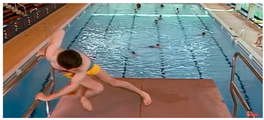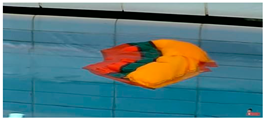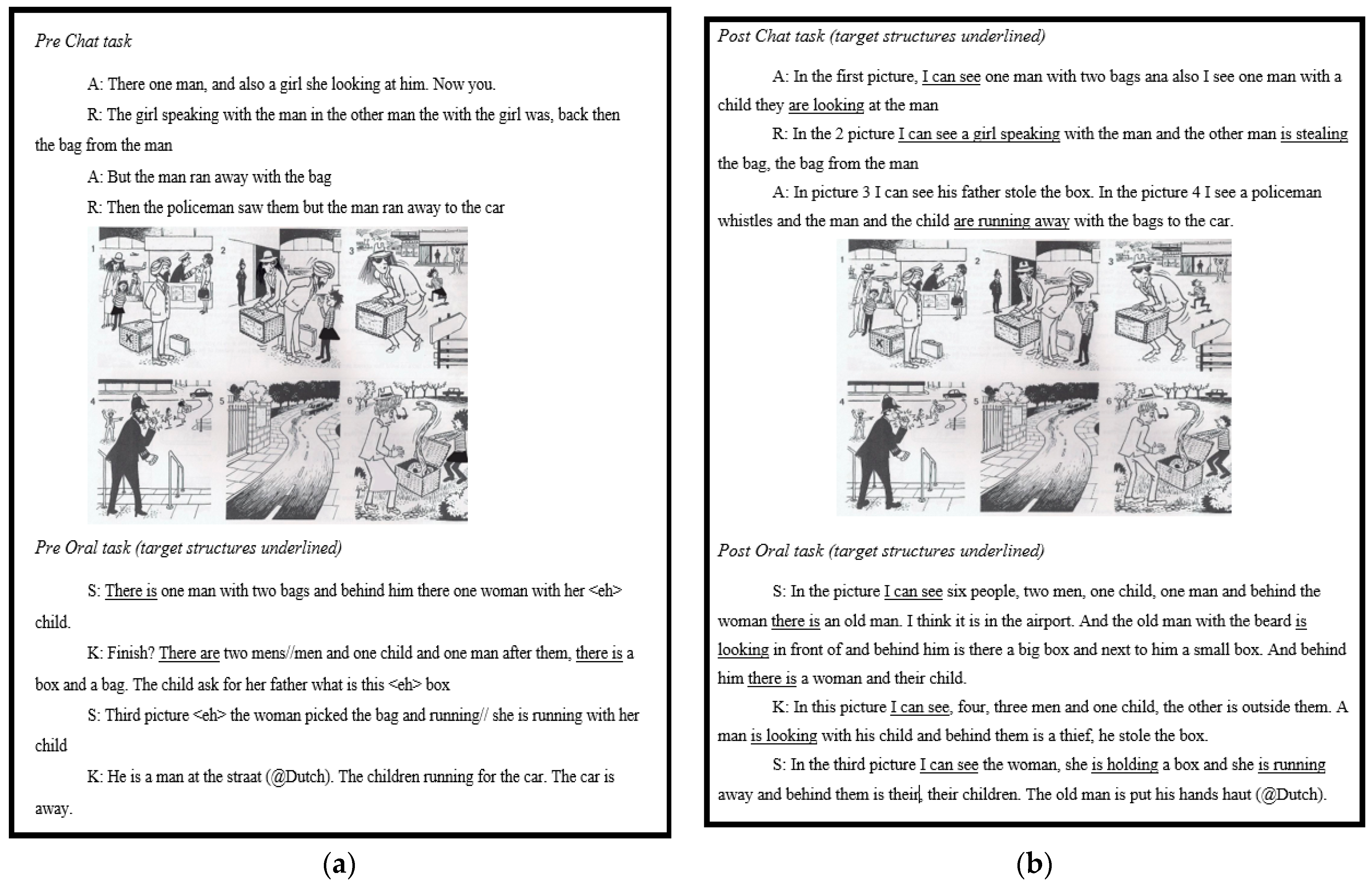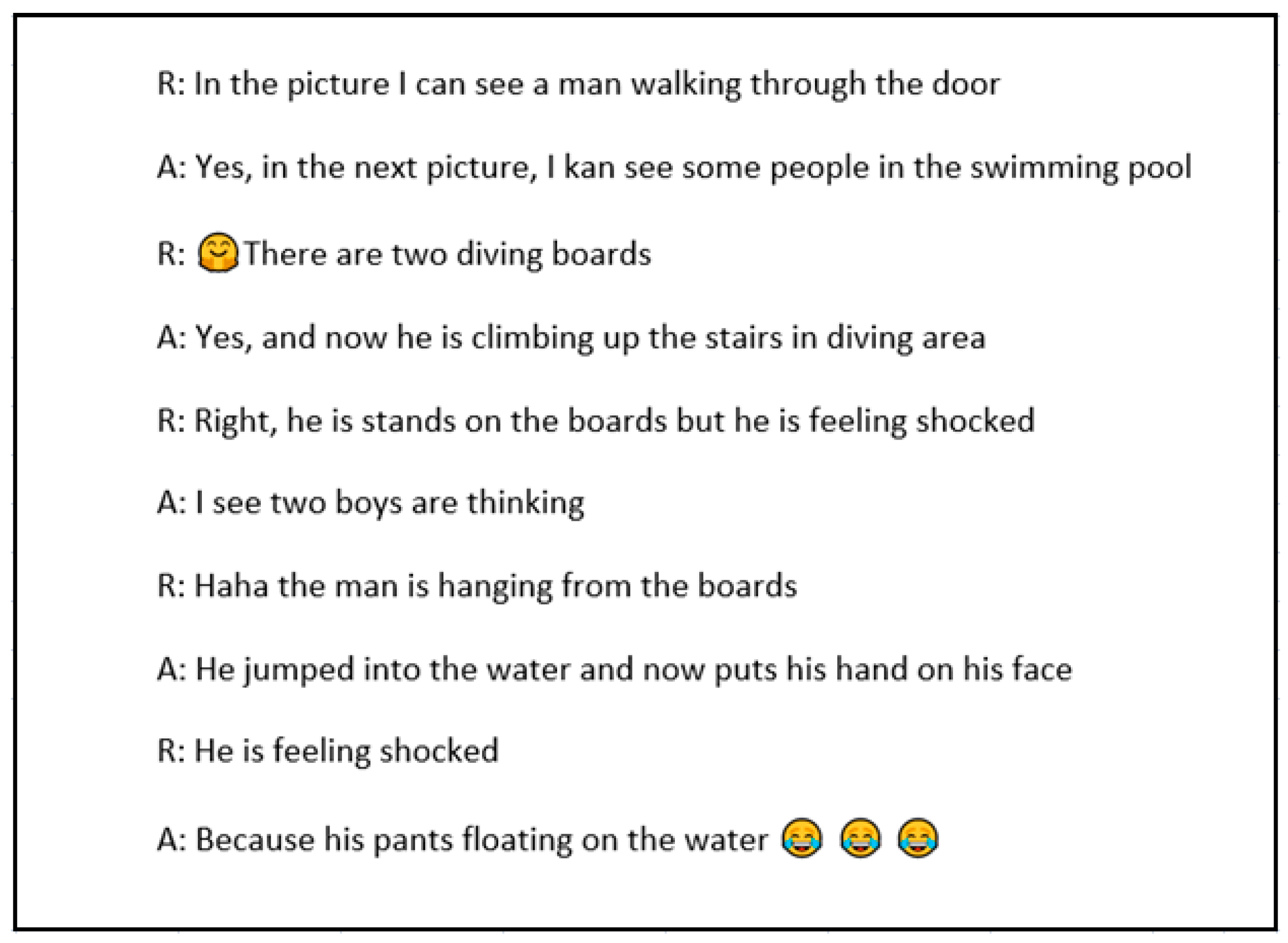Chatting with Your Peers across Modalities: Effects of Performing Increasingly Complex Written Computer-Mediated Tasks on Oral L2 Development
Abstract
1. Introduction
1.1. Written CMC and the Transferability to Oral Production
1.2. Task-Based Language Teaching, Task Complexity and Task Sequencing
1.3. Motivation and Anxiety Influencing and Influenced by Written CMC Activities
1.4. Purpose of the Present Study and Research Questions
- How does a task-based text chat instructional intervention that has adopted the SSARC model of task complexity (Robinson 2015) for task sequencing affect the oral task-based performance of L2 learners as gauged by measures of fluency, global and task-specific accuracy, as well as a holistic measure of functional language use?Based on Levelt’s (1989) model of language processing and previous claims (e.g., Payne and Whitney 2002; Payne and Ross 2005; Razagifard 2013), it was hypothesized that the SCMC learning outcomes would transfer to F2F communication. It was expected that all general measures of language proficiency would show an overall increase over time to a lesser or greater extent. It was also expected that the task-specific variables (i.e., accurate use of the target structures), would display the greatest degree of development (Robinson and Gilabert 2007).
- How does a task-based text chat instructional intervention that adopted the SSARC model of task complexity (Robinson 2015) for task sequencing relate to learners’ motivation, anxiety, and perceived use of these written CMC activities?Considering previously mixed findings, no specific hypothesis was determined. This research question was also examined by calculating the frequency of ratings on the complementary questions and tapping into the students’ and teacher’s comments. From the review of the literature (e.g., Baralt and Gurzynski-Weiss 2011; Ziegler 2016; Michel 2018), it was hypothesized that the use of SCMC in the classroom would be regarded as beneficial for language learning, as well as less stressful than F2F communication.
2. Materials and Methods
2.1. Participants
2.2. Materials
2.2.1. Pre-/Post-Tasks
2.2.2. Treatment Tasks
2.2.3. Questionnaires on Participant Characteristics and Affective Factors
2.3. Procedure
2.4. Soft- and Hardware
2.5. Coding and Analyses
2.6. Data Analyses
3. Results
3.1. Example Task-Based Performances
3.2. Descriptive and Inferential Statistics for Text-Chat and Oral Data on Pre-/Post-Tasks
3.3. Descriptive Statistics and Correlational Analyses on Motivation, Anxiety and CMC Perceptions
4. Discussion
4.1. The Transfer from L2 Text Chat to Oral Task-Based Performance and Development
4.2. Written CMC Treatment Task Design: Task Complexity and Sequencing
4.3. Language Learning Motivation, Anxiety and Task Perception
5. Limitations and Directions for Future Research
6. Conclusions and Pedagogical Implications
Author Contributions
Funding
Institutional Review Board Statement
Informed Consent Statement
Data Availability Statement
Conflicts of Interest
Appendix A. Vocabulary Worksheet Example
- In the picture, I can see a swimming pool
- They are playing with the ball
- In the picture I can see some children
- In the middle of the picture, I can see a group of people
- There are two bathing suits
- He is climbing up the stairs
- There are two diving boards
- The young boy is feeling afraid
- He is feeling shocked
- He is tired to wait
- In the picture, I can see a water splash
- In the picture, I can see a naked hippopotamus
- They are jumping
- They are throwing snowballs at each other
- The orangutan is hanging from the tree
- The man is floating on the water

- MAIN Treatment task 1
- You and your partner each have 10 frames/pictures.
- These pictures together tell a story of Mr. Bean.
- Each picture has a number. This number indicates the order of the pictures.
- Look at your pictures carefully and take a few moments (3 min) to think before you start chatting with your partner. Read the useful words and phrases!
- Chat with your partner, describe the pictures in the right order, use the useful words and phrases! Try to understand the story!
- You will describe all that you can see in the picture (the place, the people and the objects) and explain what you think is happening and how the people are feeling: What is in the picture? Where in the picture? What is happening in the picture?
- Try your best, describe the details, and tell the story! You have 10 min!
| 1 |  | 2 |  |
| 3 |  | 4 |  |
| 5 |  | 6 |  |
| 7 |  | 8 |  |
| 9 |  | 10 |  |
- Useful words and phrases for description of pictures:
- What is in the picture?
- In the picture I can see ...
- There is/There are ...
- There isn’t a ...
- Say what is happening with the present continuous
- The man/woman is ...ing
- Where in the picture?
- At the top/bottom of the picture ...
- In the middle of the picture ...
- On the left/right of the picture ...
- next to
- in front of
- behind
- near
- on top of
- under
- If something isn’t clear
- It looks like a ...
- Maybe it’s a ...
- Examples of linking words
- …because…, and, then, after that, before, but
- How to ask if you don’t understand
- I am sorry, I didn’t understand. Is the man/woman … ing?/are the people … ing?
- What do you mean by …? Maybe you want to say…?
- Could you please repeat?
Appendix B. Language Motivation and Anxiety Questionnaire (Plus 6 Statements Targeting Chat Anxiety and Technology Use) with a 7-Point Likert Scale Answer Options from ‘Strongly Disagree’ to ‘Strongly Agree’
- I would feel uneasy speaking English with/to a person who spoke that language.
- I use English language-teaching computer programs.
- I feel more tense and nervous in my language class than in my other classes.
- I often use the Internet to practice English.
- I get nervous when I’m speaking in my English class.
- I often chat in English on the Internet.
- My friends think English is cool.
- I’m afraid that other students will laugh at me when I speak English.
- People around me tend to think that it’s a good thing to know foreign languages.
- When I chat on the computer in English I am afraid that my chat partner finds me stupid when I make mistakes.
- My friends think that studying English is important.
- I feel embarrassed to write in English during a computer chat session at school.
- I put off my English homework as much as possible
- My friends are not bothered to study English.
- When I study English, I seldom do more than is necessary.
- I study English because I’d really like to be good at it.
- I find that learning English is really interesting.
- I’m ready to work hard to learn English.
- I am happy when I see that I am making progress in English.
- I study English because it will be necessary to work in English speaking countries.
- I keep up to date with English by working on it almost every day.
- Learning English is really great.
- I would feel uncomfortable using computer chat in English with/to a person who spoke that language.
- I can imagine myself reading books and magazines in English.
- When I imagine my future job, I see myself using English.
- Learning English is necessary because it is an international language.
- Studying English will help me feel part of the international community of people speaking English.
- I can imagine myself speaking English with high proficiency.
- I can imagine myself writing emails in English.
- I study English because I would like to spend some time abroad.
- I study English as it is necessary to pass my exams.
- The things I want to do in the future require that I speak English.
- I need English for my future career.
- I would really like to communicate with English speakers in the future.
| Construct | Cronbach’s Alpha |
|---|---|
| 1. Technology use (2, 4, 6) | 0.712 |
| 2. Chat anxiety (10, 12, 23) | 0.703 |
| 3. Anxiety (1, 3, 5, 8) | 0.712 |
| 4. Motivational intensity (15, 18, 21) | 0.724 |
| 5. Intrinsic motivation (16, 17, 19, 22) | 0.756 |
| 6. Ideal L2 Self (24, 25, 29) | 0.801 |
| 7. Instrumental motivation (31, 32, 33) | 0.707 |
| 8. International orientation (20, 26, 27, 34) | 0.716 |
Appendix C. Questionnaire Items on Task Perception with a 7-Point Likert Scale Answer Options from ‘Strongly Disagree’ to ‘Strongly Agree’
- By chatting on the mobile with my classmate I have learned some English.
- If I had been chatting with an English native speaker, I would have learned more.
- These chat sessions were a useful practice for future spoken conversations in English.
- These chat sessions were a helpful practice for future written tasks in English.
- Mobile chat is more similar to speaking than to writing English.
- Face-to-face communication in English is easier than communication by mobile chat.
- Face-to-face communication is better to learn English than mobile chat.
Appendix D. Holistic Rating Scale Guidelines to Global Evaluation of Language Performance
- Score 5: This is a very good result. The output is well structured. It contains a clear and complete description of the pictures and the narration of the story is logical. Ideas are clearly organized, and good use is made of linking words/phrases.
- Score 4: This is a good result. The output has a clear overall structure. All pictures are described, and the narration of the story is easy to follow most of the time. Ideas are generally well organized and linking words/phrases are generally used appropriately.
- Score3: This is a satisfactory result. It has an overall structure, but the description of some pictures may be incomplete, and the narration of the story hard to follow. Linking words/phrases may be missing or used inappropriately.
- Score 2: This is an adequate result. It is difficult to follow because the description is very incomplete, and the narration is not well organized. There is a general lack of linking words/phrases. There might be repetitions.
- Score 1: This is a poor result. It is poorly organized and difficult to follow. Description and narration are poor or absent.
| 1 | Throughout this paper, we will use the terms ‘text chat’ and ‘written CMC’ (rather than SCMC, which stands for synchronous CMC) to refer to the medium widely used in modern digital communication by means of messenger services such as WhatsApp or WeChat, given that it is no longer used in synchronous modes only (cf. Smith and González-Lloret 2021). |
| 2 | We highlight here the specific background of our participants even though this is not related to our research questions. The interested reader is referred to Gok and Michel (2021) where we shed more light on tasks for highly educated refugees in the Netherlands. |
References
- Abrams, Zsuzsanna. 2001. Computer-mediated communication and group journals: Expanding the repertoire of participant roles. System 29: 489–503. [Google Scholar] [CrossRef]
- Abrams, Zsuzsanna. 2003. The effect of synchronous and asynchronous CMC on oral performance in German. The Modern Language Journal 87: 157–67. [Google Scholar] [CrossRef]
- Baralt, Melissa, and Laura Gurzynski-Weiss. 2011. Comparing learners’ state anxiety during task-based interaction in computer-mediated and face-to-face communication. Language Teaching Research 15: 201–29. [Google Scholar] [CrossRef]
- Baralt, Melissa, Roger Gilabert, and Peter Robinson, eds. 2014. Task Sequencing and Instructed Second Language Learning. London: A&C Black. [Google Scholar]
- Beauvois, Margaret-Heily. 1992. Computer-assisted classroom discussion in the foreign language classroom: Conversation in slow motion. Foreign Language Annals 25: 455–64. [Google Scholar] [CrossRef]
- Beauvois, Margaret-Heily. 1997. Write to speak: The effects of electronic communication on the oral achievement of fourth semester French students. In New Ways of Learning and Teaching: Issues in Language Program Direction. Edited by Judith Muyskens. Boston: Heinle & Heinle Publishers, pp. 93–116. [Google Scholar]
- Blake, Christopher. 2009. Potential of text-based internet chats for improving oral fluency in a second language. The Modern Language Journal 93: 227–40. [Google Scholar] [CrossRef]
- Blake, Christopher. 2017. Technologies for teaching and learning L2 speaking. In The Handbook of Technology and Second Language Teaching and Learning. Edited by Carol A. Chapelle and Shannon Sauro. New York: John Wiley & Sons Inc., pp. 107–17. [Google Scholar] [CrossRef]
- Blake, Robert. 2000. Computer-mediated communication: A window on FL Spanish interlanguage. Language Learning & Technology 4: 120–36. [Google Scholar]
- Bygate, Martin. 2001. Effects of Task Repetition on the Structure and Control of Oral Language. In Researching Pedagogic Tasks Second Language Learning, Teaching and Testing. Edited by Martin Bygate, Peter Skehan and Merrill Swain. Upper Saddle River: Pearson Education, pp. 23–48. [Google Scholar] [CrossRef]
- Chapelle, Carol A. 2009. The relationship between second language acquisition theory and computer-assisted language learning. The Modern Language Journal 93: 741–53. [Google Scholar] [CrossRef]
- Chun, Dorothy M. 1994. Using computer networking to facilitate acquisition of interactive competence. System 22: 17–31. [Google Scholar] [CrossRef]
- Compton, Lily. 2002. From Chatting to Confidence: A Case Study of the Impact of Online Chatting on International Teaching Assistants’ Willingness to Communicate, Confidence Level and Fluency in Oral Communication. Unpublished. Master’s thesis, Department of English, Iowa State University, Ames, IA, USA. [Google Scholar]
- Darhower, Mark. 2002. Interactional features of synchronous computer-mediated communication in the intermediate L2 class: A sociocultural case study. CALICO 19: 249–78. [Google Scholar] [CrossRef]
- de Bot, Kees W., Wander Lowie, and Marjolijn Verspoor. 2005. Second Language Acquisition: An Advanced Resource Book. London: Routledge. [Google Scholar]
- de Bot, Kees W., Wander Lowie, and Marjolijn Verspoor. 2007. A Dynamic Systems Theory approach to second language acquisition. Bilingualism: Language and Cognition 10: 7–21. [Google Scholar] [CrossRef]
- Dörnyei, Zoltán. 2001. New Themes and Approaches in Second Language Motivation Research. Annual Review of Applied Linguistics 21: 43–59. [Google Scholar] [CrossRef]
- Dörnyei, Zoltán. 2003. Attitudes, orientations, and motivations in language learning: Advances in theory, research, and applications. Language Learning 53: 3–32. [Google Scholar] [CrossRef]
- Dussias, Paola. 2006. Morphological development in Spanish-American telecollaboration. In Internet-Mediated Intercultural Foreign Language Education. Edited by Julie A. Belz and Steve L. Thorne. Boston: Thomson Heinle, pp. 121–46. [Google Scholar]
- East, Martin. 2021. Foundational Principles of Task-Based Language Teaching. London: Taylor & Francis. [Google Scholar] [CrossRef]
- Ellis, Rod. 2003. Task-Based Language Learning and Teaching. Oxford: Oxford University Press. [Google Scholar]
- Foster, Pauline, and Gillian Wigglesworth. 2016. Capturing accuracy in second language performance: The case for a weighted clause ratio. Annual Review of Applied Linguistics 36: 98–116. [Google Scholar] [CrossRef]
- Gardner, Robert C. 1985. Social Psychology and Second Language Learning: The Role of Attitudes and Motivation. London: Arnold. [Google Scholar] [CrossRef]
- Gok, Seyit, and Marije Michel. 2021. Designing pedagogic tasks for refugees learning English to enter universities in the Netherlands. In The Cambridge Handbook of Task-Based Language Teaching. Edited by Mohammad Javad Ahmadian and Michael Long. Cambridge: Cambridge University Press, pp. 290–302. [Google Scholar]
- González-Lloret, Marta, and Lourdes Ortega, eds. 2014. Technology-Mediated TBLT: Researching Technology and Tasks. Amsterdam: John Benjamins Publishing Company, vol. 6. [Google Scholar] [CrossRef]
- Gurzynski-Weiss, Laura, and Melissa Baralt. 2014. Exploring learner perception and use of task-based interactional feedback in FTF and CMC modes. Studies in Second Language Acquisition 36: 1–37. [Google Scholar] [CrossRef]
- Heaton, John Brian. 1975. Beginning Composition through Pictures. London: Longman Group Limited. [Google Scholar]
- Ito, Mizuko, Heather A. Horst, Matteo Bittanti, Danah Boyd, Becky Herr-Stephenson, Patricia C. Lange, C.J. Pascoe, and Laura Robinson. 2008. Living and Learning with New Media: Summary of Findings from the Digital Youth Project. Cambridge: MIT Press. [Google Scholar] [CrossRef]
- Kelm, Orlando. 1992. The use of synchronous computer networks in second language instruction: A preliminary report. Foreign Language Annals 25: 441–54. [Google Scholar] [CrossRef]
- Kern, Richard. 1995. Restructuring classroom interaction with networked computers: Effects on quantity and characteristics of language production. The Modern Language Journal 79: 457–76. [Google Scholar] [CrossRef]
- Kormos, Judit, and Mariann Denes. 2004. Exploring measures and perceptions of fluency in the speech of second language learners. System 32: 145–64. [Google Scholar] [CrossRef]
- Kormos, Judit, Tineke Brunfaut, and Marije Michel. 2020. Motivational factors in computer-administered integrated skills tasks: A study of young learners. Language Assessment Quarterly 17: 43–59. [Google Scholar] [CrossRef]
- Kormos, Judit, Thom Kiddle, and Kata Csizér. 2011. Goals, attitudes and self-related beliefs in second language learning motivation: An interactive model of language learning motivation. Applied Linguistics 32: 495–516. [Google Scholar] [CrossRef]
- Kuiken, Folkert, and Ineke Vedder. 2008. Cognitive task complexity and written output in Italian and French as a foreign language. Journal of Second Language Writing 17: 48–60. [Google Scholar] [CrossRef]
- Kuiken, Folkert, Ineke Vedder, and Roger Gilabert. 2010. Communicative adequacy and linguistic complexity in L2 writing. In Communicative Proficiency and Linguistic Development: Intersections between SLA and Language Testing Research. Edited by Inge Bartning, Maisa Martin and Ineke Vedder. EuroSLA Monographs Series 1; Amsterdam: EuroSLA, pp. 81–100. [Google Scholar]
- Lai, Chun, and Yong Zhao. 2006. Noticing and text-based chat. Language Learning and Technology 10: 102–20. [Google Scholar]
- Lambert, Craig, and Peter Robinson. 2014. Learning to perform narrative tasks: A semester-long classroom study of L2 task sequencing effects. In Task Sequencing and Instructed Second Language Learning. Edited by Melissa Baralt, Roger Gilabert and Peter Robinson. London: Bloomsbury, pp. 207–30. [Google Scholar]
- Levelt, Willem. 1989. Speaking: From Intention to Articulation. Cambridge: MIT Press. [Google Scholar] [CrossRef]
- Lin, Wei-Chen, Hung-Tzu Huang, and Hsien-Chin Liou. 2013. The effects of text-based SCMC on SLA: A meta-analysis. Language Learning & Technology 17: 123–42. [Google Scholar]
- Loewen, Shawn, and Masatoshi Sato. 2018. Interaction and instructed second language acquisition. Language Teaching 51: 285–329. [Google Scholar] [CrossRef]
- Lowie, Wander, Marije Michel, Audrey Rousse-Malpat, Merel Keijzer, and Rasmus Steinkrauss, eds. 2020. Usage-Based Dynamics in Second Language Development. Cleveldon: Multilingual Matters. [Google Scholar]
- Manchón, Rosa. 2011. Writing to learn the language: Issues in theory and research. Learning-to-Write and Writing-to Learn in an Additional Language 61: 82. [Google Scholar] [CrossRef]
- Michel, Marije. 2017. Complexity, accuracy and fluency in L2 production. In Routledge Handbook of Instructed Second Language Acquisition. Edited by Shawn Loewen and Masatoshi Sato. (Routledge Handbooks in Applied Linguistics). London: Routledge, pp. 50–68. [Google Scholar]
- Michel, Marije. 2018. Practicing online with your peers: The role of text chat for second language development. In Practice in Second Language Learning. Edited by Cristian Jones. Cambridge: Cambridge University Press, pp. 164–96. [Google Scholar] [CrossRef][Green Version]
- Ocando Finol, Maria. 2019. Past the Anthropocentric: Sociocognitive Perspectives for Tech-Mediated Language Learning. Annual Review of Applied Linguistics 39: 146–51. [Google Scholar] [CrossRef]
- Ortega, Lourdes. 1997. Processes and outcomes in networked classroom interaction: Defining the research agenda for FL computer-assisted classroom discussion. Language Learning and Technology 1: 82–93. [Google Scholar]
- Oxford, Rebecca L., and Judith Burry-Stock. 1995. Assessing language learning strategies worldwide with the ESL/EFL version of the strategy inventory for language learning (SILL). System 23: 1–23. [Google Scholar] [CrossRef]
- Payne, Scott J., and Brenda M. Ross. 2005. Synchronous CMC, working memory, and L2 oral proficiency development. Language Learning and Technology 9: 35–54. [Google Scholar]
- Payne, Scott J., and Paul J. Whitney. 2002. Developing L2 oral proficiency through synchronous CMC: Output, working memory, and interlanguage development. CALICO Journal 20: 7–32. [Google Scholar] [CrossRef]
- Pelletieri, Jill. 2000. Negotiation in cyberspace: The role of chatting in the development of grammatical competence. In Network Based Language Teaching: Concepts and Practice. Edited by Mark Warschauer and Richard Kern. Cambridge: Cambridge University Press, pp. 59–86. [Google Scholar]
- Razagifard, Parisa. 2013. The impact of text-based CMC on improving L2 oral fluency. Journal of Computer Assisted Learning 29: 270–79. [Google Scholar] [CrossRef]
- Révész, Andrea, Marije Michel, and Roger Gilabert. 2016. Measuring cognitive task demands using dual task methodology, subjective self-ratings, and expert judgments: A Validation Study. Studies in Second Language Acquisition 38: 703–37. [Google Scholar] [CrossRef]
- Robinson, Peter. 2001. Task complexity, task difficulty and task production: Exploring interactions in a componential framework. Applied Linguistics 22: 27–57. [Google Scholar] [CrossRef]
- Robinson, Peter. 2005. Cognitive complexity and task sequencing: Studies in a componential framework for second language task design. International Review of Applied Linguistics 43: 1–32. [Google Scholar] [CrossRef]
- Robinson, Peter, ed. 2010. Second Language Task Complexity: Researching the Cognition Hypothesis of Language Learning and Performance. Amsterdam: John Benjamins Publishing Company. [Google Scholar] [CrossRef]
- Robinson, Peter. 2015. The Cognition Hypothesis, second language task demands, and the SSARC model of pedagogic task sequencing. In Domains and Directions in the Development of TBLT: Plenaries from a Decade of the International Conference. Edited by Martin Bygate. Amsterdam: John Benjamins Publishing Company, pp. 87–122. [Google Scholar] [CrossRef]
- Robinson, Peter, and Roger Gilabert. 2007. Task complexity, the cognition hypothesis and second language learning and performance. International Review of Applied Linguistics in Language Teaching 45: 161–76. [Google Scholar] [CrossRef]
- Rousse-Malpat, Audrey, Rasmus Steinkrauss, Martjin Wieling, and Marjolijn Verspoor. 2022. Communicative language teaching: Structure-Based or Dynamic Usage-Based? Journal of the European Second Language Association 6: 20–33. [Google Scholar] [CrossRef]
- Samuda, Virginia, and Martin Bygate. 2008. Tasks in Second Language Learning. New York: Palgrave. [Google Scholar] [CrossRef]
- Satar, Muge, and Nesrin Özdener. 2008. The effects of synchronous CMC on speaking proficiency and anxiety: Text versus voice chat. The Modern Language Journal 92: 595–613. [Google Scholar] [CrossRef]
- Sauro, Shannon. 2011. SCMC for SLA: A research synthesis. CALICO Journal 28: 369–91. [Google Scholar] [CrossRef]
- Sauro, Shannon, and Bryan Smith. 2010. Investigating L2 performance in text chat. Applied linguistics 31: 554–77. [Google Scholar] [CrossRef]
- Scovel, Thomas. 1978. The effect of affect on foreign language learning: A review of the anxiety research. Language Learning 28: 129–42. [Google Scholar] [CrossRef]
- Skehan, Peter. 2009. Modeling second language performance: Integrating complexity, accuracy, fluency, and lexis. Applied Linguistics 30: 510–32. [Google Scholar] [CrossRef]
- Skehan, Peter, and Pauline Foster. 2001. Cognition and Tasks. In Cognition and Second Language Instruction. Edited by Peter Robinson. Cambridge: Cambridge University Press, pp. 183–205. [Google Scholar] [CrossRef]
- Smith, Bryan, and Marta González-Lloret. 2021. Technology-Mediated Task-Based Language Teaching: A Research Agenda. Language Teaching 54: 518–534. [Google Scholar] [CrossRef]
- Smith, Karen L. 1990. Collaborative and interactive writing for increasing communication skills. Hispania 73: 77–87. [Google Scholar] [CrossRef]
- Spoelman, Marianne, and Marjolijn Verspoor. 2010. Dynamic patterns in development of accuracy and complexity: A longitudinal case study in the acquisition of Finnish. Applied Linguistics 31: 532–53. [Google Scholar] [CrossRef]
- Storch, Neomy. 2005. Collaborative writing: Product, process, and students’ reflections. Journal of Second Language Writing 14: 153–73. [Google Scholar] [CrossRef]
- Tyler, Andrea E. L., Lourdes Ortega, Mariko Uno, and Hae In Park, eds. 2018. Usage-Inspired L2 Instruction: Researched Pedagogy. Amsterdam: John Benjamins Publishing Company, vol. 49. [Google Scholar] [CrossRef]
- Van de Guchte, Marrit C., Gert Rijlaarsdam, Martine Braaksma, and Peter Bimmel. 2019. Focus on language versus content in the pre task: Effects of guided peer-video model observations on task performance. Language Teaching Research 23: 310–29. [Google Scholar] [CrossRef]
- Verspoor, Marjolijn. 2017. Complex dynamic systems theory and L2 pedagogy. In Complexity Theory and Language Development: In Celebration of Diane Larsen-Freeman. Amsterdam: John Benjamins Publishing Company, pp. 143–62. [Google Scholar] [CrossRef]
- Willis, Jane. 1996. A Framework for Task-Based Learning. Harlow: Longman, vol. 60. [Google Scholar]
- Wolfe-Quintero, Kate S., Shunji Inagaki, and Hae-Young Kim. 1998. Second Language Development in Writing: Measures of Fluency. In Accuracy, and Complexity. Honolulu: University of Hawaii Press. [Google Scholar]
- Yuan, Fangyuan, and Rod Ellis. 2003. The Effects of Pre-Task Planning and On-Line Planning on Fluency, Complexity and Accuracy in L2 Monologic Oral Production. Applied Linguistics 24: 1–27. [Google Scholar] [CrossRef]
- Ziegler, Nicole. 2016. Taking technology to task: Technology-mediated TBLT, performance, and production. Annual Review of Applied Linguistics 36: 136–63. [Google Scholar] [CrossRef]



| Construct | Measures |
|---|---|
| 1. Fluency | Oral: speaking rate (SR); average length of pauses. Text chat: total number of clauses; total number of words. |
| 2. Global accuracy | 1st, 2nd, and 3rd degree errors; ratio of total errors per 50 words. |
| 3. Task-specific accuracy | Use of: present continuous; existential ‘there is/are’; can + infinitive. |
| 4. Functional use of language (FLU) | Storch’s (2005) 5-scale global evaluation scheme. |
| Text Chat | Oral | |||||||||
|---|---|---|---|---|---|---|---|---|---|---|
| Pre | Post | Gain | Pre | Post | Gain | |||||
| Measure | M | SD | M | SD | % | M | SD | M | SD | % |
| FLUENCY | ||||||||||
| Total Number of Clauses | 4.40 | 2.06 | 6.13 | 2.07 | 39.3 | - | - | - | - | |
| Total Number of Words | 50.6 | 19.4 | 59.1 | 19.5 | 16.8 | - | - | - | - | |
| Speaking Rate | - | - | - | - | 1.63 | .970 | 1.76 | 0.588 | 8.0 | |
| Average Pause Length | - | - | - | - | 2.63 | 1.66 | 1.65 | 1.12 | 37.3 | |
| GLOBAL ACCURACY | ||||||||||
| 1st Grade Errors | 0.900 | 1.11 | 0.366 | 0.639 | 59.3 | 0.071 | 0.18 | 0.431 | 0.385 | −507.0 |
| 2nd Grade Errors | 3.73 | 2.76 | 2.73 | 2.19 | 26.8 | 5.43 | 2.56 | 3.64 | 1.98 | 33.0 |
| 3rd Grade Errors | 1.10 | 1.55 | 0.800 | 1.37 | 27.3 | 1.07 | 0.916 | 0.535 | 0.949 | 50.0 |
| Ratio total number errors per 50 words | 6.01 | 3.03 | 3.22 | 1.89 | 46.4 | 5.20 | 1.94 | 2.70 | 1.59 | 48.1 |
| TASK-SPECIFIC ACCURACY | ||||||||||
| Present continuous | 0.400 | 0.83 | 1.73 | 1.87 | 332.5 | 0.500 | 0.76 | 3.64 | 2.59 | 628.0 |
| Existential There is/are | 0.133 | 0.351 | 0.333 | 0.487 | 150.4 | 0.714 | 0.913 | 0.928 | 1.49 | 30.0 |
| Can + Infinitive | 0.066 | 0.258 | 1.87 | 1.64 | 2733.3 | 0.142 | 0.362 | 3.50 | 1.45 | 2364.8 |
| FUNCTIONAL LANGUAGE USE | 2 | 0.925 | 2.27 | 0.798 | 13.5 | 1.57 | 0.65 | 2.71 | 0.870 | 72.6 |
| Text Chat Pre- vs. Post-Task | Oral Pre- vs. Post-Task | |||||||
|---|---|---|---|---|---|---|---|---|
| Measure | Test (t/V) | df | p | ES | Test (t/V) | df | p | ES |
| FLUENCY | ||||||||
| Total Number of Clauses | 2.25 t | 14 | 0.041 * | 0.839 | - | - | - | - |
| Total Number of Words | 1.47 t | 14 | 0.165 | 0.435 | - | - | - | - |
| Speaking Rate | - | - | - | - | 78 V | 14 | 0.118 | 0.251 |
| Average Pause Length | - | - | - | - | −2.27 t | 14 | 0.040 * | 0.284 |
| GLOBAL ACCURACY | ||||||||
| 1st Grade Errors | −1.45 t | 14 | 0.167 | 0.590 | 2.92 t | 14 | 0.011 * | 1.19 |
| 2nd Grade Errors | −1.78 t | 14 | 0.096 | 0.204 | 1.5 V | 14 | 0.014 * | −0.925 |
| 3rd Grade Errors | 8 V | 14 | 0.298 | 0.714 | 3 V | 14 | 0.119 | −0.571 |
| Ratio of total number of errors per 50 words | −4.20 t | 14 | 0.001 ** | −1.10 | −4.64 t | 14 | 0.001 ** | 1.41 |
| TASK-SPECIFIC ACCURACY | ||||||||
| Present continuous | 59 V | 14 | 0.021 * | 0.833 | 4.25 t | 14 | 0.001 ** | 1.65 |
| Existential There is/are | 20 V | 14 | 0.298 | 0.428 | 7.5 V | 14 | 1 | 0.333 |
| Can + Infinitive | 4.73 t | 14 | 0.001 ** | 1.53 | 105 V | 14 | 0.001 ** | 0.973 |
| FUNCTIONAL LANGUAGE USE | 38.5 V | 14 | 0.227 | 0.400 | 78 V | 14 | 0.001 ** | 0.956 |
| Pre-Task Text Chat vs. Oral | Post-Task Text Chat vs. Oral | |||||||
|---|---|---|---|---|---|---|---|---|
| Measure a | Test (t/V) | df | p | ES | Test (t/V) | df | p | ES |
| GLOBAL ACCURACY | ||||||||
| 1st Grade Errors | −0.77 V | 14 | 0.001 ** | 0.903 | 10 V | 14 | 0.539 | 1.19 |
| 2nd Grade Errors | −1.97 t | 14 | 0.068 | −0.607 | −1.82 t | 14 | 0.090 | −0.435 |
| 3rd Grade Errors | 31 V | 14 | 0.887 | 0.010 | 9 V | 14 | 0.783 | 0.201 |
| Ratio of total number of errors per 50 words | 1.156 t | 14 | 0.266 | 0.331 | 1.483 t | 14 | 0.161 | 0.284 |
| TASK-SPECIFIC ACCURACY | ||||||||
| Present continuous | −0.396 t | 14 | 0.697 | −0.169 | −2.40 t | 14 | 0.031 * | 0.789 |
| Existential There is/are | 1.5 V | 14 | 0.065 | 0.189 | 0 V | 14 | 0.097 | 0.341 |
| Can + Infinitive | 2 V | 14 | 0.772 | 0.087 | 0 V | 14 | 0.002 ** | 0.233 |
| FUNCTIONAL LANGUAGE USE | 21.5 V | 14 | 0.218 | 0.181 | −2.28 t | 14 | 0.040 * | −0.505 |
| Score (Number of Items per Construct) | Mean | SD | 2 | 3 | 4 | 5 | 6 | 7 | 8 |
|---|---|---|---|---|---|---|---|---|---|
| 1 Technology use (3) | 4.04 | 1.54 | −0.304 | 0.192 | 0.392 | 0.356 | 0.665 ** | 0.623 * | 0.597 * |
| 2 Chat anxiety (3) | 3.28 | 1.34 | 0.453 | 0.112 | 0.224 | −0.394 | −0.043 | −0.245 | |
| 3 Anxiety (4) | 3.36 | 1.28 | 0.324 | 0.378 | −0.109 | 0.113 | 0.078 | ||
| 4 Intensity (3) | 4.33 | 1.22 | 0.676 ** | 0.425 | 0.354 | 0.569 * | |||
| 5 Intrinsic (3) | 4.62 | 1.31 | 0.332 | 0.087 | 0.367 | ||||
| 6 Ideal L2 Self (3) | 4.46 | 1.15 | 0.612 * | 0.759 ** | |||||
| 7 Instrumental (3) | 4.62 | 1.13 | 0.645 * | ||||||
| 8 International Orientation (4) | 5.08 | 1.10 |
Publisher’s Note: MDPI stays neutral with regard to jurisdictional claims in published maps and institutional affiliations. |
© 2022 by the authors. Licensee MDPI, Basel, Switzerland. This article is an open access article distributed under the terms and conditions of the Creative Commons Attribution (CC BY) license (https://creativecommons.org/licenses/by/4.0/).
Share and Cite
Korvesi, E.; Michel, M. Chatting with Your Peers across Modalities: Effects of Performing Increasingly Complex Written Computer-Mediated Tasks on Oral L2 Development. Languages 2022, 7, 276. https://doi.org/10.3390/languages7040276
Korvesi E, Michel M. Chatting with Your Peers across Modalities: Effects of Performing Increasingly Complex Written Computer-Mediated Tasks on Oral L2 Development. Languages. 2022; 7(4):276. https://doi.org/10.3390/languages7040276
Chicago/Turabian StyleKorvesi, Evgenia, and Marije Michel. 2022. "Chatting with Your Peers across Modalities: Effects of Performing Increasingly Complex Written Computer-Mediated Tasks on Oral L2 Development" Languages 7, no. 4: 276. https://doi.org/10.3390/languages7040276
APA StyleKorvesi, E., & Michel, M. (2022). Chatting with Your Peers across Modalities: Effects of Performing Increasingly Complex Written Computer-Mediated Tasks on Oral L2 Development. Languages, 7(4), 276. https://doi.org/10.3390/languages7040276






